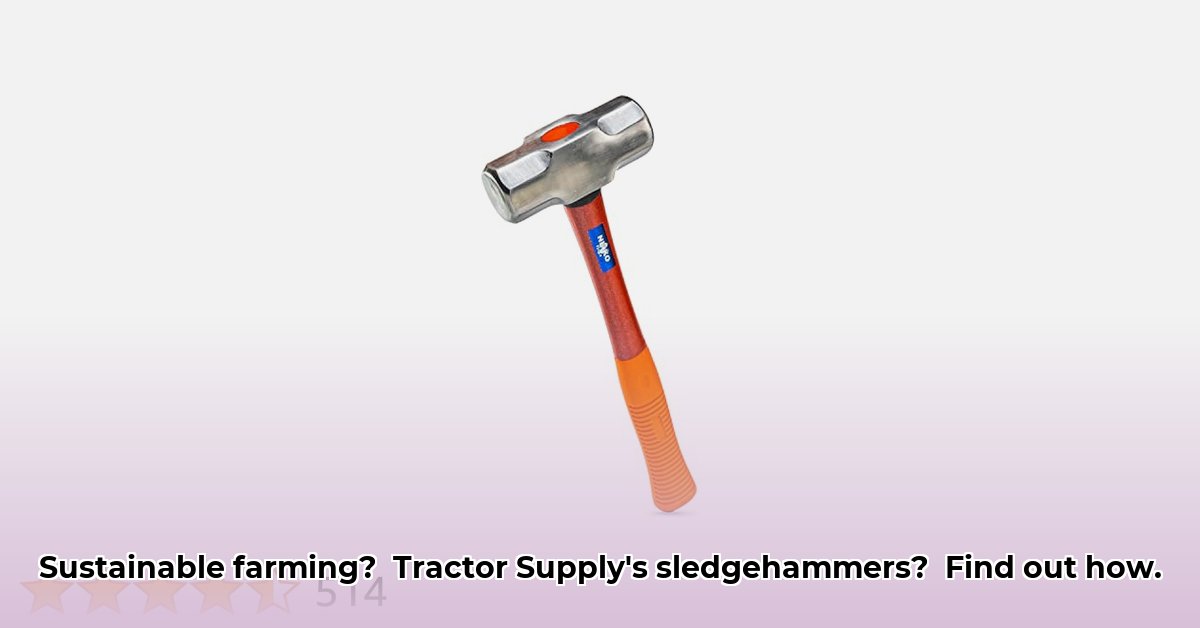
GroundWork Sledgehammer: A Case Study in Sustainable Tooling for Agriculture
This case study examines the GroundWork sledgehammer, available at Tractor Supply, as a lens through which to analyze the intersection of sustainable agricultural practices and tooling. While the sledgehammer's immediate impact might seem minimal, its entire life cycle—from manufacturing to disposal—reveals crucial insights into broader sustainability challenges within agriculture. This analysis emphasizes the need for greater transparency and research into the environmental impact of seemingly simple farming tools. For additional resources on sustainable farming practices, check out this helpful resource.
GroundWork Sledgehammer Analysis: Durability and Data Gaps
The GroundWork sledgehammer boasts a durable design, featuring a steel head and fiberglass handle, suggesting longevity and reduced replacement needs. This inherent durability points towards potential environmental benefits by lessening the demand for new tools and minimizing waste. However, crucial data gaps exist. Current information lacks detailed specifics regarding the embodied energy (the total energy used in a product's lifecycle) of its production, the sourcing of its constituent materials (steel and fiberglass), and its end-of-life management options (recyclability, reusability, or disposal). This lack of information severely limits a comprehensive sustainability assessment. While anecdotal evidence suggests durability, quantitative data on its overall environmental footprint is currently unavailable.
Sustainability Implications: A Life-Cycle Perspective
A truly sustainable assessment requires a cradle-to-grave analysis. This means evaluating the environmental impact at each stage:
Manufacturing: The energy consumption in steel production and fiberglass manufacturing significantly impacts the sledgehammer's carbon footprint. The sourcing of raw materials—the mining of iron ore and the manufacturing of fiberglass—adds another layer of environmental consideration, particularly concerning potential habitat disruption or pollution. Further research is needed into the specific processes and their associated emissions.
Use: The sledgehammer's impact in the field is primarily associated with soil compaction. While this effect varies based on usage intensity and soil type, the potential for soil degradation needs to be factored into its overall assessment. Moreover, the worker safety aspects (potential for injuries) should also be considered, as these can lead to economic and social costs.
Disposal: The end-of-life impact is largely unknown. Information regarding the sledgehammer's recyclability and the feasibility of material recovery is needed. Without clear guidance on responsible disposal, the possibility of landfill accumulation and associated environmental damage is a significant concern.
Therefore, while its durability suggests a positive environmental aspect, a complete life-cycle assessment is crucial for determining its true sustainability.
Comparative Analysis: Alternatives and Their Sustainability Credentials
Alternative methods and tools exist for tasks typically performed using a sledgehammer. These alternatives present a spectrum of sustainability profiles:
| Method | Upsides | Downsides | Sustainability Considerations |
|---|---|---|---|
| Traditional Sledgehammer | Reliable, readily available, good for specific tasks | Potential for soil compaction, worker injuries, unknown environmental impact | Requires comprehensive life-cycle assessment and improved material sourcing transparency |
| Smaller Mallet/Pickaxe | Reduced soil compaction, lighter weight | Less power, potentially more labor-intensive | Lower embodied energy potentially, but life-cycle assessment still crucial. |
| Mechanized Tools | Increased efficiency, reduced labor intensity | High embodied energy, reliance on fossil fuels | Requires consideration of energy sources and maintenance practices |
| No-till farming techniques | Reduced soil disruption, improved soil health | Requires specialized equipment, potential weed challenges | Reduces the need for many soil-disturbing tasks, thus potentially lessening tool dependency. |
This comparison highlights the importance of carefully weighing the trade-offs between efficiency, labor intensity, and environmental impact when choosing agricultural tools.
Recommendations and Future Research
To foster more sustainable agricultural practices, we need concerted action from various stakeholders:
| Stakeholder | Recommended Actions |
|---|---|
| Farmers/Agriculturalists | Evaluate tool needs, explore alternatives, adopt best practices for tool maintenance and disposal. |
| Tool Manufacturers | Conduct full life-cycle assessments, prioritize recycled/sustainable materials, improve end-of-life management strategies. |
| Researchers | Investigate embodied energy, material sourcing sustainability, and end-of-life options for various tools. Develop innovative, sustainable tool designs. |
| Policy Makers | Implement incentives and regulations promoting the use of sustainable agricultural tools and practices. Support research and development in sustainable agriculture technologies. |
Further research is critical to fill existing data gaps and facilitate informed decision-making. Specifically, life-cycle assessments for various agricultural tools, including the GroundWork sledgehammer, are urgently needed. This will allow for a more robust comparison and the identification of truly sustainable options.
Conclusion
The GroundWork sledgehammer, while seemingly simple, exemplifies the complexity of achieving true sustainability in agriculture. A comprehensive understanding of a tool's full life cycle, considering manufacturing, usage, and disposal, is paramount. By prioritizing research, transparency, and collaborative efforts across the agricultural value chain, we can work towards a more sustainable and resilient food system. The seemingly small choices we make regarding agricultural tools can have surprisingly large consequences for the environment. Focusing on sustainability in this area is a critical step towards a greener future.